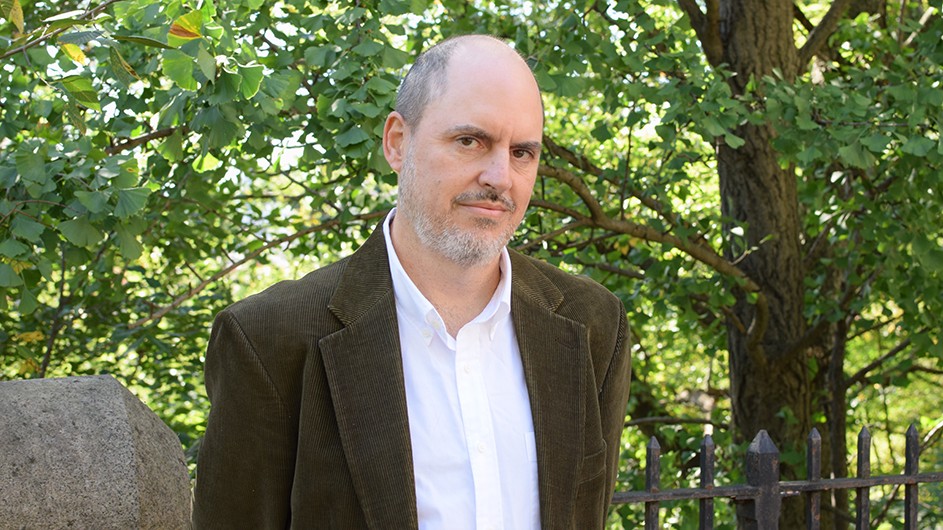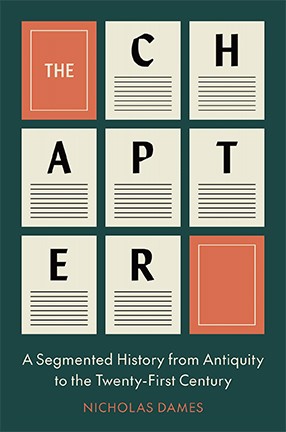Why Do Books Have Chapters?
Nicholas Dames provides the answer in his new volume.

The Chapter: A Segmented History From Antiquity to the Twenty-First Century, by Nicholas Dames, the Theodore Kahan Professor of Humanities, embarks on a literary journey spanning two millennia, revealing how an ancient editorial technique became a universally recognized component of narrative art and a means to register the sensation of time.
Dames begins with the textual compilations of antiquity, where chapters evolved as a tool to organize information. He moves on to the earliest divisional systems of the Gospels and the segmentation of medieval romances, describing how the chapter took on new purpose when applied to narrative texts, and how narrative segmentation gave rise to a host of aesthetic techniques. Dames discusses writers ranging from Sterne, Goethe, Tolstoy, and Dickens to George Eliot, Machado de Assis, and Jennifer Egan. Spanning ancient tablets and scrolls to contemporary fiction and film, The Chapter provides a history of a familiar compositional mode that readers often take for granted.
Dames talks about the book with Columbia News, along with what moves him most in a work of literature, whether a book has ever brought him closer to another person, and what he’s reading these days.
Why did you write this book?
At a certain point in a scholarly career, it’s a natural impulse to address a big, unanswered question that has nagged at you for a long time. One such question was posed to me by a friend, over drinks, almost two decades ago: Why do novels have chapters, and what work do they do? It’s a “why is the sky blue” sort of question, and those can be profound; they stagger you in a good way. The question pointed to something fundamental about how novels train us in different kinds of temporal rhythms, and how those rhythms change slowly, more slowly than fashions in plots or topics or character types.
The question also intrigued me because it suggested I’d have to think in a long, historical framework, something I hadn’t been able to do up to that point in my career, but was eager to try. Such a project would take me outside of my immediate area of expertise, and it would take time to get up to speed in other fields; this meant I’d have to wait a bit. Finally, after a gap of some years, I found myself in a position to start that work.

One has to read your book to get the full answer, but can you give a synopsis of why books have chapters?
Chapters, as a mode of segmenting longer texts, go back to classical antiquity, and are older even than the codex, our form of book. There are chapter divisions and chapter headings in ancient scrolls, and even, occasionally, in texts published in the form of public tablets. The first thing to understand is: Chapters have been a component of literate or textual culture for a very long time. (Whether as caput in Latin or kephalaion in Greek, these early avatars of “chapter” derive from “head,” meaning “chief elements” or “main topics.”)
Where they’re initially present, however, tends to be in texts we could loosely call informational—ancient compendia of knowledge, whether medical, legal, historical, or something like literary-critical. A chapter is a way of segmenting long texts to enable what historians of reading call “discontinuous access”—not reading sequentially through a text, but instead locating the places in a text where the information you’re seeking can be found. To afford this kind of reading involves two intertwined tasks—dividing a text into useful units, and labeling those units with a heading of some kind, which can be found in various places, sometimes in a separate list. You can think of these two functions as segmenting and indexing. A chapter does both. It's a tool of knowledge facilitation, a locating device. While it could be produced by authors in antiquity, more commonly, it was an editorial function, something done to texts after their initial composition.
Over time, this technique begins to be applied to texts that aren’t simply informational, but are narratives—longer stories. One of my earliest examples is the Gospels, which are chaptered, or divided, in multiple ways from the fourth century to the 13th century, in systems devised in different places and for different purposes. (The chapters found in our Bibles date from the 13th century.) These several divisional systems of Gospel narratives vary tremendously: Some come with headings, some don’t; some offer many small chapters; others, fewer, larger ones.
But it’s at this point—roughly speaking, in late antiquity—that chapters start to be imagined as components of prose narratives, and even, eventually, prose fictions. When this happens, the chapter changes its function—slowly, but decisively. It goes from being a device to facilitate informational access, a labeling device, to a technique for marking time in narratives. It becomes a kind of clock, aligning a reader’s time to the time within a story.
And at this point—particularly, in the kinds of narratives we call novels—the chapter can become a complex aesthetic tool, something that writers can play with to shape a reader’s rhythm; it’s a multi-dimensional act of patterning and synchronization. This is, of course, far from those ancient labels that marked informational texts, but there is a traceable line that gets us from that older notion to the newer one. So chapters evolve from a labeling device to a timing device.
What do you read when you're working on a book? And what kind of reading do you avoid while writing?
Sometimes in the process of writing, you can get in a rut; you can hear your voice skipping and repeating like a dusty LP. When this happens, I like to pick up something by a great essayist. It helps to have other voices in your head for a bit, especially those voices that you feel an affinity with but aren’t quite your own, as a kind of reset, cleaning the grooves. Some touchstone examples for me might be Jenny Diski, Elizabeth Hardwick, Janet Malcolm, Adam Phillips. Jan Morris’s travel writing. Brilliant younger essayists and critics like Frank Guan, Tobi Haslett, Emily Ogden. Those names for starters.
As for the reading to avoid, that’s simple—tweets. It’s hard not to let social media tie you into a knot of self-consciousness. I feel it in my gut.
What moves you most in a work of literature?
The honest but unhelpful answer—great sentences. Sentences that are constructed in brilliant, inimitable ways, that have some stamp of individuality. The way a Henry James sentence, for instance, is so very much his own. But, of course, like every reader, I have my own idiosyncratic list of scenarios or themes to which I’m particularly susceptible. Parent-child relationships and the kinds of knowingness they involve. The irreversibility of time, and the ways we try nonetheless to reverse it. And stories that try to grapple with states of happiness—the hardest thing to do well, I often think. The literature of happiness is notably small.
Has a book ever brought you closer to another person, or come between you?
Reading aloud to my children when they were young certainly counts as the most memorable, or significant, way a book has brought me closer to someone else. As for the contrary, I’m glad to live in a time when disagreements about books don’t end in duels, or fistfights at cocktail parties. But doesn’t (silent) reading inevitably come between us and others? As a bit of a recluse, I’m thankful for the opportunity to be unreachable. The first time I read Proust, in my early twenties, I stayed indoors for days on end and unplugged my phone; it was a magical refusal of the world around me, and I wish I could repeat it more easily.
What books have you read lately that you would recommend, and why?
J.M. Coetzee’s Jesus Trilogy, which I came to belatedly—the final volume, The Death of Jesus, came out in 2019. It’s impressed me as one of the greatest works I know of the century so far. Coetzee is always coolly detached, a bit of a game-player, but the game here is the opposite of cool: It really does push past allegory into something like myth, 21st-century myth.
And then, haunting me all year, the least detached of books—the Romanian writer Mircea Cartarescu’s Solenoid, which I wrestled with for a review; it’s 700 pages of death-metal hallucinogenic intensity that’s trying to push at every possible boundary. Including mortality: One of Cartarescu’s inventions here is a sect called the Picketists, who picket morgues, cemeteries, hospices, futilely protesting death itself. How’s that for a 21st-century structure of feeling?
What's next on your reading list?
First up is Sofia Samatar and Kate Zambreno’s Tone, which excites me because it addresses a loose concept that literary theory has tended to avoid. And I’m anxious to get to Journeys of the Mind, the new memoir by Peter Brown, the preeminent historian of late antiquity. I have a weakness, all too predictably I suppose, for academic memoirs, for details (dreadful, nostalgic, absurd) of what a life in higher education used to be like.
You're hosting a dinner party. Which three academics/writers, dead or alive, would you invite, and why?
I’ll trust friends and family for intimate, sympathetic gatherings. For this opportunity, I’d lean instead into the dinner party as a theater for epigrammatists and monologuists, masters of the cutting and the catty, and let them fight it out to see who could hold court the most memorably. And if it’s my fantasy, I’d stick to novelists, those who relished conversational brilliance, even—or especially—when it’s combative.
Let’s start with Stendhal, Napoleonic trooper and post-Imperial diplomat turned chronicler of drawing-room competitiveness, who hated being bored or boring. Put him next to his contemporary, Jane Austen, who shared with him nothing except for a deep understanding of the social aggression of wit. Then I’d bring in Muriel Spark, whose jokes could draw blood. This would have every chance of being a disaster. I’d be hanging on every word.
There will be a panel discussion about The Chapter sponsored by the Society of Fellows and Heyman Center for the Humanities at 6:15 pm on November 29.